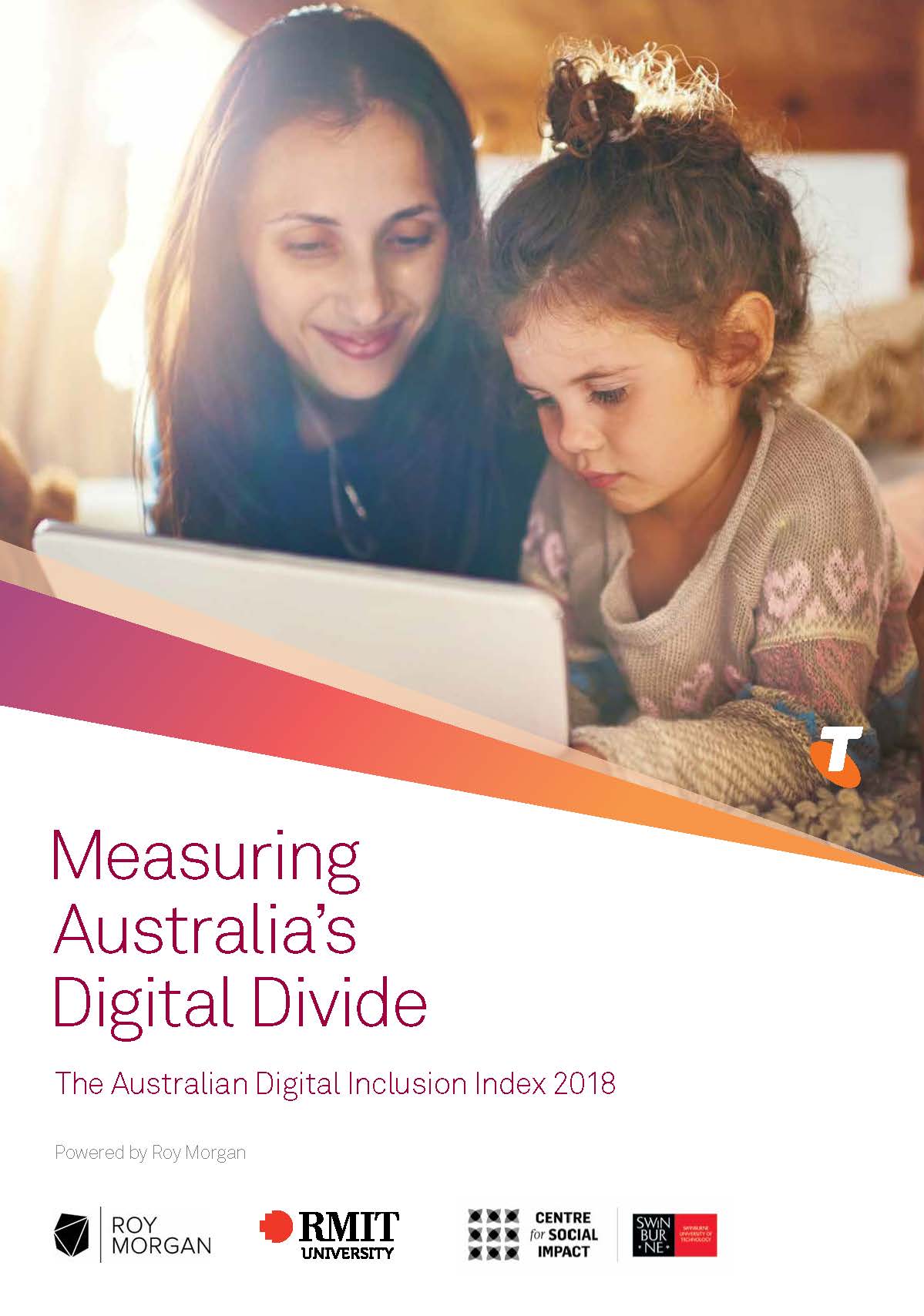This case study was originally published in the 2018 Australian Digital Inclusion Index report, and is derived from the Roy Morgan Single Source dataset. As of 2021, the Australian Digital Inclusion Index is based on the Australian Internet Usage Survey (AIUS). The numerical results of this case study cannot be compared with the refreshed ADII data.
Australian telecommunication advertising commonly portray families using home internet to satisfy a wide range of social, entertainment, work, and educational needs. This depiction of home internet as a ‘family essential’ reflects the high rate of family household connectivity.
The 2016 Census, ABS data, and the ADII reveal that more than nine in 10 family households maintain home internet access, a greater level of connectivity than other household types1. This is true for both two-parent and single parent families. However, connectivity does not tell a complete story and, in the case of single parents, obscures significant digital disadvantage.
The socio-economic disadvantage of single parent families with dependent children is well documented2. These families represent 7% of Australian households and are overwhelmingly headed by women3. Single parents have low rates of employment and many rely entirely on government benefits4. This results in very low household income – more than 20% live below the poverty line. The ADII reveals this socio-economic disadvantage translates into digital disadvantage – not only impacting on affordability, but also on the quality of internet access, the range of online activities conducted, and attitudes to digital engagement.
Overall, single parent families have an ADII score of 56.5, 3.7 points lower than the national average and 10.0 points lower than two-parent families5. Although their Access sub-index score is higher than the national average, single parent families are less likely to invest in fixed broadband access than other Australians (67.0% versus 72.9% national average). A greater dependence on rental housing and the higher levels of uncertainty and mobility this entails is one barrier to fixed broadband investment.
Fixed broadband plans generally provide higher speed and more reliable connections, with larger and more cost-effective data allowances than mobile connections. A greater reliance on mobile-only access translates into lower levels of engagement in higher-bandwidth streaming and communication activities by single parent families. Instead, single parents are more likely to engage in functional online activities, such as financial transactions and government interactions.
Given their socio-economic circumstances, single parents tend to have regular contact with government agencies. Such agencies increasingly promote online contact and self-management of claims through apps such as MyGov6 on the grounds that it reduces costs for providers and users. Given lengthy call centre and face-to-face service queues, single parents might derive some transactional benefits from online contact, but online systems can also be unreliable and difficult to navigate7. This may be one factor which makes single parents less likely than other Australians to feel that computers and technology are empowering (40.4% versus 46.4% national average). Furthermore, those with mobile-only plans endure higher costs for accessing government services online.
Affordability is the key barrier to greater digital inclusion for single parents. The impact of internet access on single parent family budgets is substantial – it accounts for 2% of their household income compared to the national average of 1.17%. This results in a Relative Expenditure score of 32.2 – 22.1 points lower than the national average. With greater reliance on mobile connections, single parents, on average, get poorer value for money than other Australians – their Value of Expenditure score is 58.4 compared to the national average of 60.9.
The complex picture of the nature and level of digital inclusion for single parent families derived from the ADII points to a range of intervention options, such as targeted fixed-broadband provisioning in social housing (where there is a concentration of single parents)8; more flexible fixed broadband options for those in the private rental market; and data-use exemptions.
Further information
For more information, including related data tables and the full citation list, please refer to the 2018 Australian Digital Inclusion Index.
References and footnotes
[1] In this report family households are those with dependent children present. There is some variation in how the Australian Bureau of Statistics (ABS) and ADII determine dependency, and thus the number of single parent families. The ABS Census classifies family household dependents as children aged under 15 years and full-time students aged 15-24 years (9% of all families). The ABS Household Use of Information Technology survey limits families with dependent children to those aged under 15 years. The ADII classifies family household dependents as those aged under 18 years. The ADII category Single Parent Families is based on survey responses from parents living in a single parent household structure with children aged under 18 years (7% of all families). The ADII category Two-Parent Families is based on survey responses from parents living in a two-parent household structure with children aged under 18 years. All Family Households are the aggregate of single and two-parent families.
[2] C.f. Australian Institute of Health and Welfare 2017. Australia’s welfare 2017. Australia’s welfare series no. 13. AUS 214. Canberra: AIHW.
[3] Australian Bureau of Statistics (2017). 2016 Census of population and housing: General community profile, Australia (Cat no. 2001.0). Canberra: ABS. Available: www.censusdata.abs.gov.au/census_services/getproduct/census/2016/communityprofile/036
[4] Wilkins, R. (2017). The Household, Income and Labour Dynamics in Australia Survey: Selected Findings from Waves 1 to 15. Melbourne: Commonwealth of Australia. Available: melbourneinstitute.unimelb.edu.au/hilda
[5] ADII scores for families in this case study are drawn from the general ADII dataset (Roy Morgan Single Source). In this dataset for 2018 the sample sizes for family types are as follows: Single Parents 386, Two-Parent Families 1888, All Families 2384.
[6] Australian Government (2018). About myGov. Australian Government. Available: my.gov.au/mygov/content/html/about.html
[7] Australian National Audit Office (2015). Management of Smart Centres’ Centrelink Telephone Services. Commonwealth of Australia. Available: www.anao.gov.au/work/performance-audit/management-smart-centres-centrelink-telephone-services; Sleep, L. & Tranter, K. (2017). The Visiocracy of the Social Security Mobile App in Australia. International Journal for the Semiotics of Law, Volume 30, Issue 3, pp 495–514. For examples of consumer frustrations also see reviews of government apps (such as Express Plus Centrelink) on Google Play and the App Store.
[8] Infoxchange and ACCAN (2016). Social Housing and Broadband: Internet Use and Affordability for Social Housing Residents, Australian Communications Consumer Action Network, Sydney.
Citation
Thomas, J, Barraket, J, Wilson, C, Ewing, S, MacDonald, T, Tucker, J & Rennie, E, 2018, Measuring Australia’s Digital Divide: The Australian Digital Inclusion Index 2018, RMIT University, Melbourne, for Telstra. DOI: www.dx.doi.org/10.25916/5b594e4475a00







